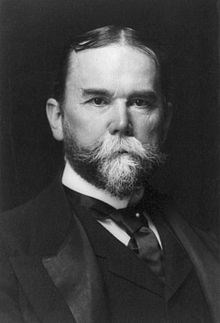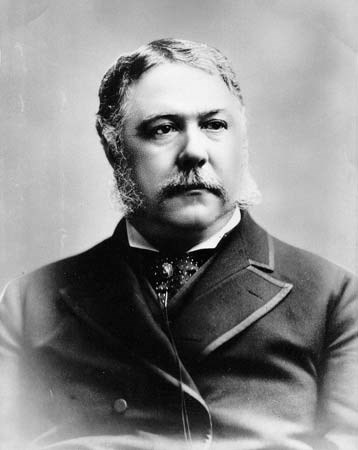Last updated: October 30, 2020
Article
James A. Garfield and a Black Washingtonian, Part II

Historical Society of Washington, D.C.
After the war, Wormley had become so successful that, in 1869, he purchased the initial portion of the previously mentioned Wormley Hotel main building, located at the SW corner of 15th and H Streets to add to his business locations. He then alternately referred to the original collection of five boarding houses and a restaurant on I Street as the “Annex” and the “Branch Hotel”. While Garfield was spreading his national image and building his house in the city, Wormley’s newest structure had become the privately owned, yet public, seat of political maneuvering, high society and statesmanship in the District.

Library of Congress
As a military and political leader in support of the rights of Blacks, Garfield had to be in touch with Wormley fairly frequently. Unfortunately, since this research regarding Garfield has just begun we have not, as yet, uncovered expansive direct information about their personal relationship. We do know that as Mr. Garfield entered upon his life in the White House the existence of the relationship became more widely known.
In the fall of 1879 John Hay and his wife had taken up a two month residence at Wormley’s Hotel while they waited for their new home a block away on H Street to be finished. Just a few years previously in this same building it was reported that the Presidential election of Rutherford B. Hayes had been negotiated. During the period 1880 to 1881 the patrons of the hotel included famous and wealthy aristocrats like the Astors, Henry Adams, the Alexander Graham Bell family, Louis Comfort Tiffany, Garfield’s presidential election Democratic opponent General Winfield Scott Hancock, Robert Lincoln and family and the Hawaiian Annexation Commission.

Library of Congress
During his Presidency Garfield appointed several close black friends of Wormley to prominent federal appointments including Frederick Douglass, John M. Langston, and Blanche K. Bruce. The well known Post Office “Star Route Scandal” investigations originating under Garfield’s administration included an allegation that Henry Bowen attempted a $25,000 bribe while at the hotel. Garfield’s Postmaster Thomas L. James, charged by Garfield to clean out the corruption, was a Wormley’s patron and was honored at a banquet at the hotel on March 16, 1881 which was attended by members of the Cabinet and Supreme Court.
Garfield, as part of his pre-inauguration activities on the evening of March 3, 1881, spoke at the hotel to his fellow Williams College alumni and is quoted as saying, “…Tonight I am a private citizen. Tomorrow I shall be called to assume new responsibilities and, on the day after, the broadside of the world’s wrath will strike.”
For the next few months the new President would settle into his duties at the White House, which brings us to Saturday, July 2, 1881, the day of his shooting. After the attack by Charles J. Guiteau, the President was brought to the White House to minister to his wounds. Among the early attendees to the needs of the President was James Wormley. James had been known to be called to attend to the care of many prominent men of the 19th century including President Lincoln after his shooting and also to attend to his son Willie who had lain dying in the White House nearly 20 years earlier. According to many accounts Wormley also had been a “nurse” to political luminaries the likes of Clay, Calhoun, Webster, Sumner and many others. As likely the most famous caterer and nurse of his time, James was asked to care for the needs of Garfield as he lay attempting to recuperate from his wounds and the ministrations of his physicians in the White House.

Library of Congress
According to an article in the New York Herald dated July 26, 1881, Wormley was immediately sought out to prepare the meals of the President by the attending physician, Dr. Willard Bliss. One of the foods most requested by the President was something called “beef tea.” This concoction was prepared from the finest tenderloin available. The meat was placed upon a broiling iron, not to cook but to sear the surface. It was then placed into a mechanical press provided from Wormley’s which compressed the meat with a pressure of 300-400 pounds until all the juices had been squeezed out of the steak. The juice or “tea” according to contemporary sources was one of the most nutritious foods provided to the President as he attempted to recuperate. Multiple news accounts, such as that in the Times Picayune on August 9, 1881, report that most of the foods provided for the suffering President came from Wormley’s farm and country homes on Pierce Mill Road on the outskirts of the city.
Despite the best care available and the aid of mechanical appliances devised by inventors like Alexander Graham Bell, the President died on September 19, 1881. Wormley, as an expression of his sorrow, commissioned a large white funerary bouquet in the shape of an angel holding a silver trumpet and about the size of a five year old child which was suspended above the coffin as the President lay in state.
The body was transported to Cleveland in a train from Washington with members of the family. It was followed approximately 20 minutes later by a train for dignitaries. This train was catered by James Wormley and his staff as it made its way to Cleveland. This catering for the train resulted in a bill for liquors, wines and lunches in an amount exceeding $1,700.00 and was the source of some consternation as reported in the Daily Globe on March 29, 1882.
Garfield’s Vice President and successor, Chester A. Arthur, had already been a patron of Wormley’s and that continued throughout his administration. One of the most important accomplishments of Garfield and, ultimately, Arthur was the viable creation of the Civil Service Commission. The first meetings of the Commission were held in the rooms of Chairman Dorman B. Eaton at Wormley’s.
James Wormley survived Garfield for only a few short years, dying from complications from surgery in Boston in 1884. It seems that both of these significant men would have survived but for the relatively primitive medical procedures undertaken on their behalf. Perhaps the scholarship around these two men will bring greater illumination to how the leader of the nation would have engaged in regular intercourse with a Black man in our nation’s capital over their twenty years of daily prominent existence within a few blocks of each other.
-Donet D. Graves, Esq., Volunteer Contributor, James A. Garfield National Historic Site, June 2014 for Garfield Observer.
